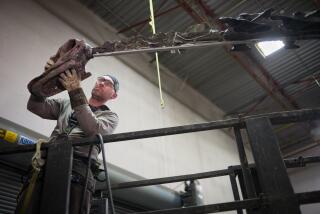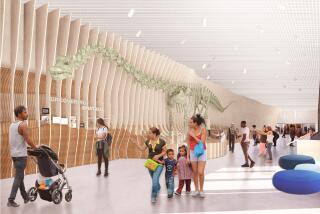‘Dinosaur graveyard’ is discovered in Utah
Los Angeles researchers have discovered a “dinosaur graveyard” in southeast Utah that is yielding a wealth of fossilized animals and footprints from the Jurassic and Cretaceous periods.
The centerpiece of the new finds is the well-preserved skeleton of a 150-million-year-old sauropod, a long-necked herbivore, that researchers have named Gnatalie because they were “eaten alive” by gnats while excavating it this year.
The team has excavated only part of the fossilized skeleton, which they estimate to be about 50 feet long. “It’s big and takes a lot of time,” said paleontologist Luis M. Chiappe, director of the Dinosaur Institute at the Natural History Museum of Los Angeles County.
Gnatalie was found in the remains of what was once a big riverbed and is now a light-colored stratum on the face of an exposed cliff. Nearby in the bed were the disarticulated remains of other sauropods and meat-eating dinosaurs, including the 5-foot-long femur of a brachiosaur.
On the ridgeline of the cliff, the team found a large number of footprints preserved in sandstone. Surprisingly, one set of sauropod prints from the Jurassic era, which ended about 145 million years ago, was found near tracks of carnivorous theropods and herbivorous ornithopods from the early Cretaceous period, which ended about 65 million years ago.
Most stunning of all to Chiappe were the three-toed prints of a European stegosaurus named Deltapodus. “Deltapodus tracks have never been found in North America,” he said.
Chiappe and his staff, led by Doug Goodreau and Aisling Farrell, expect to spend at least another decade excavating the site.
The finds will be featured in an exhibit at the Natural History Museum slated to open in 2011, Chiappe said.
A renovation of the dinosaur exhibit is part of an $84-million project to restore and seismically strengthen the museum’s original 1913 beaux-arts-inspired building.
--
More to Read
Sign up for Essential California
The most important California stories and recommendations in your inbox every morning.
You may occasionally receive promotional content from the Los Angeles Times.










